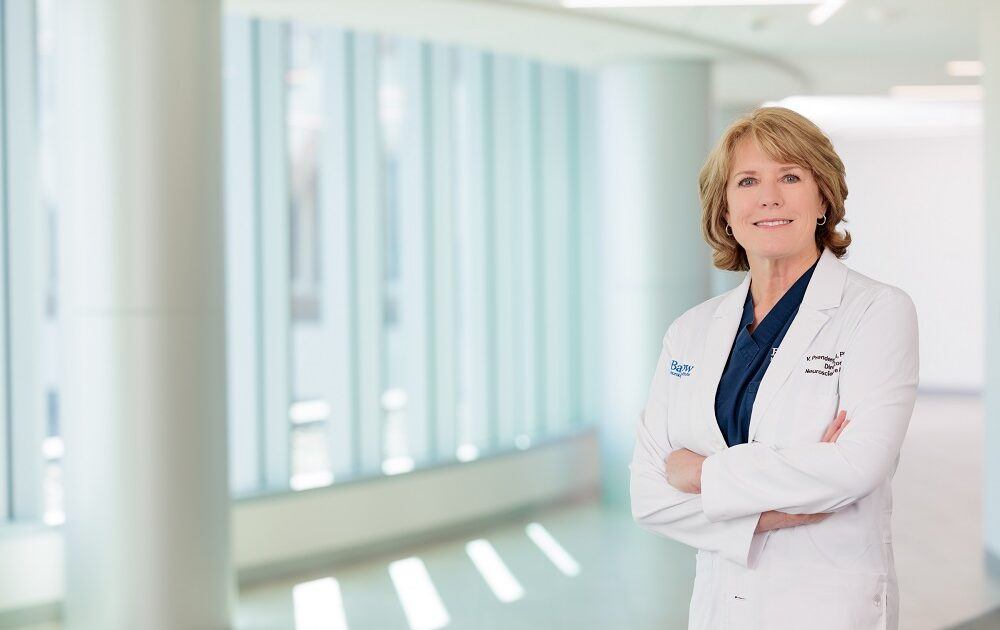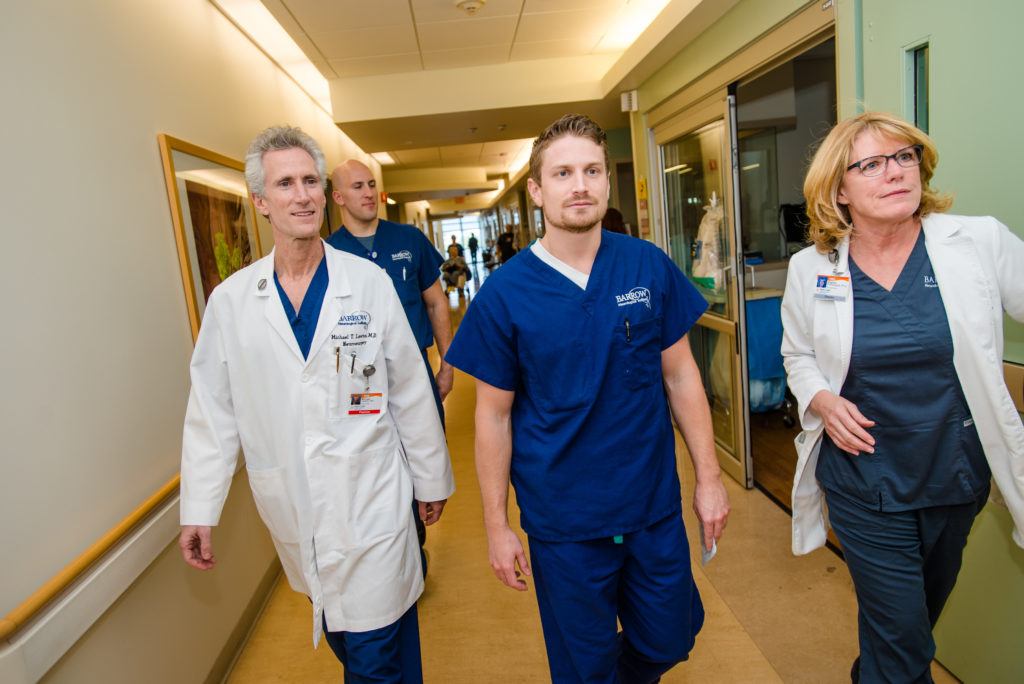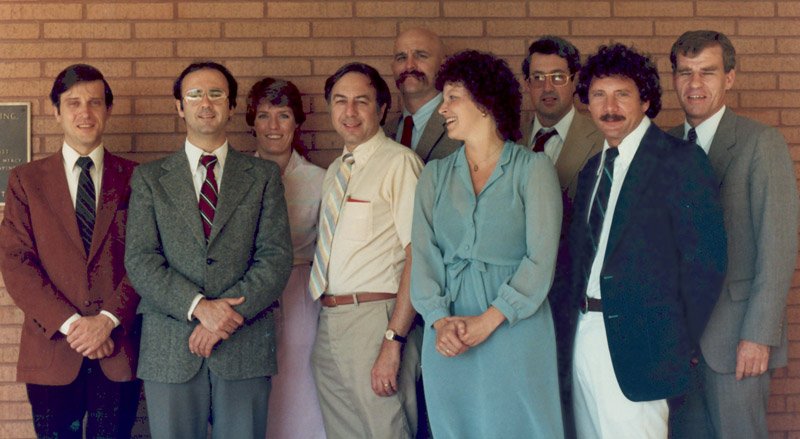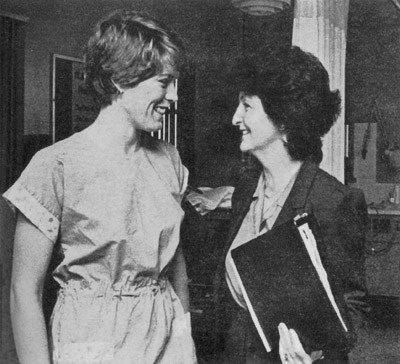
Meet Virginia Prendergast, PhD: Director of Advanced Practice Nursing
One day, Virginia Prendergast, PhD, was humming a Frank Sinatra tune while walking through the hallways of Barrow Neurological Institute. Dr. Robert Spetzler remarked that she seemed to be in a good mood.
“I said, ‘I am, because I’m on the other side of the rail,’” she recalled.
It was in 1979, during Virginia’s first weekend as a Neurological Intensive Care Unit nurse, that she realized just how fortunate she was to be on the other side of the bedrail.
“Growing up, I never used to wear my seatbelt,” she confessed. Wearing a seatbelt wasn’t required by law then, but Virginia admits she had a cavalier attitude toward safety as a young adult.
“I remember walking out of the ICU and thinking: I am so blessed,” she said. “I’ve worn my seatbelt ever since.”
For Virginia, being a nurse reminds her to embrace every day. She is known around Barrow for her grateful mindset and positive attitude.
“In addition to being an extraordinary nurse, she is an educator, an innovator, an inspiration, and as I experience every morning on rounds, a reliable dose of energy and sunshine,” said Dr. Michael T. Lawton, president and CEO of Barrow.
Nursing Dreams: Coming Full Circle
As far back as she can remember, Virginia wanted to become a nurse. At age 5, she begged her father to schedule a tour of St. Joseph’s Hospital and Medical Center, where she was born and where Barrow is located. Every year for Halloween, she dressed as a hospital volunteer in a candy striper uniform.
Virginia’s interest in neurosciences began in the 1970s when she was pursuing her Bachelor of Science in Nursing at the College of St. Teresa in Winona, Minnesota. As a 20-year-old student nurse working at Mayo Clinic in Rochester, she found herself caring for a 17-year-old who had sustained a traumatic brain injury.
“I just remember thinking that it was up to me to do the very best job I could,” she said. “Because the better I did, the better he would do.”
That’s when she realized that she needed to make her way back to her hometown of Phoenix, Arizona and to Barrow Neurological Institute—a world-renowned neuroscience center.
From Bedside Nurse to Director
Virginia began working as a bedside nurse in the Neuro ICU at Barrow and quickly ascended the leadership ladder to head nurse.
She stepped down to start her family, returned to bedside nursing, and then decided to pursue a Master of Science in Nursing at Arizona State University so that she could fulfill her passion for teaching. After graduation, she accepted a job as a clinical nurse specialist in the Neuro ICU.
“That was fulfilling for a while, and then I got itchy to get back to direct patient care,” she said.
Virginia enrolled at the University of Arizona to obtain her Adult and Geriatric Nurse Practitioner Post-Master’s Certificate. After working all day at the hospital, she would drive to U of A for night class. She and a classmate would quiz each other on the four-hour round-trip commute.

After graduation, Virginia became the first nurse practitioner on the inpatient service at St. Joseph’s Hospital and Medical Center.
“I loved it because I could see patients; work closely with nurses, residents, and physicians; and I could teach,” she said. “It was a win-win-win.”
Today, Virginia serves as director of advanced practice nursing at Barrow. She describes the job as three-fold: clinical, education, and research.
On the clinical side, she follows patients who undergo surgery with Dr. Lawton.
“There are only a small handful of nurses that I have encountered in my entire career whose impact on patient care is so profoundly positive that outcomes improve just by their being on the team,” Dr. Lawton said. “Virginia is one of those nurses. She is dedicated to our patients, provides phenomenal care, and makes things happen for healing to occur.”
‘Pushing the Mark’ in Nursing Education
The education component of Virginia’s job includes ensuring that nurses are meeting the continuing education requirements needed for license renewal. She also helps her staff achieve and maintain special certifications. Barrow has more certified registered neuroscience nurses (CNRNs), including Virginia herself, than any other hospital in the world.
It’s just one example of how she strives to “push the mark” for nursing at Barrow. Another is the creation of the Barrow Neuroscience Nursing Symposium. Virginia approached Barrow’s founding medical director, Dr. John Green, 39 years ago about creating a conference dedicated to nursing.

“There was such support from the physicians and such a tremendous embrace from our nurses,” she recalled.
What started as a four-hour program has evolved into two full days of education and collegiality. Each year, Virginia asks a patient and their family to share their story with the audience. Naturally, she calls this talk “The Other Side of the Rail.”
This year, Barrow will offer the symposium in a virtual, on-demand format due to the COVID-19 pandemic.
Putting the Right Tools in Nurses’ Hands
The third aspect of Virginia’s role is research. Her largest research project has focused on the connection between oral health and systemic diseases. This led her to invent a special electric toothbrush for dependent patients, for which Dignity Health now holds a patent.
She found her motivation from a patient problem: the challenge of providing good oral care to hospitalized patients. This was especially true for patients on life support—those who need oral care the most.
“Nurses come to work every day, and they want to do a good job,” she said. “If we don’t put the right tools in their hands, then we’re not doing the best job. I’ve been a nurse for 42 years, and we’re still using the same thing we were using 42 years ago.”
The problem nagged at her so much that she ended up going back to school to do something about it. She attended the University of Lund in Sweden and earned her PhD in health science. While there, she focused her studies on the safety and efficacy of oral care in critically ill patients.
Virginia collaborated with a dental hygienist to design the toothbrush, which features dual LED lights as well as suction and irrigation capabilities. It is currently in development and will be available to Barrow patients as early as 2021. She hopes it will eventually reach hospitals worldwide.
Responding to COVID-19 with ‘Resilience Rooms’
In March, Virginia sought to address another new problem. She sat in her office thinking about the surge of COVID-19 cases in New York City and what could be in store for Arizona hospitals.
“I wanted to make sure that we had a way to help our nurses take good care of themselves,” she said.
Virginia envisioned resilience rooms, where nurses could decompress. Thanks to the support of the Barrow Women’s Board and generous donors, Virginia got to work creating two types of rooms. One is an active room, featuring workout equipment. The other is a quiet room, offering massage chairs and a calming visual exercise.
While COVID-19 highlighted the need for resilience rooms, Virginia noted that nurses will continue to benefit from additional support long after the pandemic ends.
Virginia expects these rooms to open within weeks. She will collect data on the effect they have on her staff’s mental and physical well-being by having them fill out questionnaires about their experiences.
The Barrow Difference
During her 42 years as a nurse, Virginia has seen Barrow evolve in countless ways. Beds once operated with a crank are now driven with the touch of a button. Nurses have traded dresses and nylon tights for Barrow-branded scrubs. The hospital has gone from having smoking and nonsmoking patient rooms to becoming a tobacco-free campus.
Some things, however, haven’t changed at all. Barrow remains a destination for cutting-edge procedures and holds a reputation for pushing boundaries in medicine. It has also long been known for its family culture. That’s why Virginia returned to Barrow after a brief stint in private practice in Colorado.

“I just missed everything about Barrow—that culture, that aggressive pursuit of excellence,” she said. “I missed the greater good it was doing. You look at all the research being done here, and I feel that our work goes further. It’s deeper, it’s broader, and it has a greater impact.”
Virginia credits her team with where she is today. She expressed gratitude for their willingness to cover her duties while she made trips to Sweden for her PhD and for always supporting her ideas.
“I really have been surrounded by such incredible people,” she said. “I’m a better person because of the people that I work with. I’m just surrounded by such good, decent, intelligent, caring, dedicated people. All of them. This is the best place in the world.”
Reflections on Leadership
Virginia admires the engagement, drive, leadership, and zest for learning among her team. Her advice to aspiring nurses is to follow that example.
“Be where your feet are,” she said. “If you are at work, be 100% at work. Be all in. But look at the horizon and make sure you’re always looking something up, learning something, setting a goal for yourself.”
She says leadership is about being a lamp, a ladder, or a lifeboat—a philosophy she borrowed from the poet Rumi and included in her PhD dissertation.
I’m a better person because of the people that I work with. I’m just surrounded by such good, decent, intelligent, caring, dedicated people. All of them. This is the best place in the world.”
Virginia Prendergast, PhD, Director of Advanced Practice Nursing
“You can be a lamp, an educator, and light the way for the next generation of people around you,” she explained. “You can be a ladder, so that people can use you to go further, or a lifeboat—sometimes people are adrift and need your help.”
Virginia hesitates to talk about her proudest accomplishments, remembering her grandmother’s words of caution: “Pride before the fall.” That is, unless she’s talking about her three children and how much she admires the people they’ve become.
But if she had to choose, her proudest accomplishment in nursing is knowing that she’s made a difference.
“The difference might be in my patient or in the patient’s family or in one of my colleagues,” she said. “I think the rewarding thing is that it’s not over. There are no limits.”
